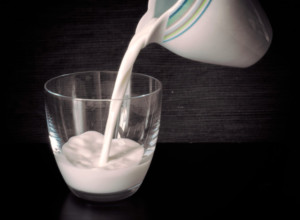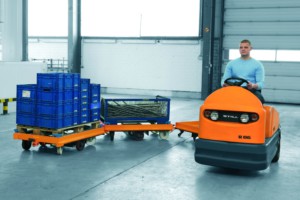 In this second post on the topic of milk runs, I will look at the organizational issues around the milk run: what kind of transport can you use, and what should the source warehouse be like. I will also talk about optional extras like repacking or kitting. Let’s start.
In this second post on the topic of milk runs, I will look at the organizational issues around the milk run: what kind of transport can you use, and what should the source warehouse be like. I will also talk about optional extras like repacking or kitting. Let’s start.
Type of Transport
There are a few organizational issues for a milk run to work. The first one is the type of transport. For external logistics this would be a type of truck. A human could push along a cart, but more commonly I have seen small trains where a tractive unit pulls a number of carts.
 Automated guided vehicles (AGV) that deliver goods driver-less are also possible, although here you need to ensure that there is a person or process for unloading the goods and loading the empty boxes. See my post on Karakuri Kaizen Examples for inspiration. For a milk run you would need these carts and tractors, and your plant should have drive paths and corners that they can pass through safely.
Automated guided vehicles (AGV) that deliver goods driver-less are also possible, although here you need to ensure that there is a person or process for unloading the goods and loading the empty boxes. See my post on Karakuri Kaizen Examples for inspiration. For a milk run you would need these carts and tractors, and your plant should have drive paths and corners that they can pass through safely.
 Electric tractors commonly pull a number of carts. These may have shelves for smaller boxes, or carts that have stacks of boxes, or even carts that can fit an entire pallet. They could have a roof and even a tarpaulin if the train has to cross into different buildings exposed to the elements.
Electric tractors commonly pull a number of carts. These may have shelves for smaller boxes, or carts that have stacks of boxes, or even carts that can fit an entire pallet. They could have a roof and even a tarpaulin if the train has to cross into different buildings exposed to the elements.
Often the materials have assigned spots on the different carts. Material A goes on cart 1 shelf 2, material B on cart 2 shelf 1, and so on. If possible, put all material for one destination close to each other so that the driver does not have to walk to different carts. Hip-height material is most ergonomic, so you could opt to put heavier or more commonly needed materials there.
In any case, if it is unloaded manually, the driver should have easy access to the required material, and should not have to handle multiple boxes to get to the material he wants. The boxes should be of a weight or size so that they can be unloaded easily by hand. If the boxes are larger or heavier, or if the train also contains pallets, you may have to provide handling equipment like a small forklift or crane.
There are even some nice gizmos that can make loading and unloading easier. Since the driver will be doing a lot of loading and unloading, any small help can make him more efficient. See for example the short video below:
Source Warehouse
 The source warehouse also needs to be easily accessed for the milk run. The material has to be readily available, without lengthy delays due to a material request into the warehouse management system. Naturally, you should not run out of stock at the source warehouse. I have seen systems where the material was provided on pallets on the floor or on shelves that are easily accessible for the drivers. It looks just like a supermarket with shelves and pallets.
The source warehouse also needs to be easily accessed for the milk run. The material has to be readily available, without lengthy delays due to a material request into the warehouse management system. Naturally, you should not run out of stock at the source warehouse. I have seen systems where the material was provided on pallets on the floor or on shelves that are easily accessible for the drivers. It looks just like a supermarket with shelves and pallets.
For very advanced plants this can also be used with Ship-to-Line, where the goods are unloaded from a truck into a small buffer stock (ca. two hours) for the milk run, after which the milk run delivers the goods to the line. However, this is quite advanced, and if you don’t have it yet I recommend starting with a milk run (easier) before attempting Ship-to-Line.
Optional: Repacking
 Often the source warehouse is also used for repacking. If the material arrives in containers that are too big, made from cardboard, or otherwise not suitable for delivery to the line, there is the option to take the material out of the packaging and put it into smaller boxes that are then brought to the assembly by the milk run. The advantages are smaller quantities and hence leaner material supply, avoidance of cardboard and other trash at the line, and customized containers that are easy to use at the assembly location. On the other hand, you need someone (often the driver) to do the repacking.
Often the source warehouse is also used for repacking. If the material arrives in containers that are too big, made from cardboard, or otherwise not suitable for delivery to the line, there is the option to take the material out of the packaging and put it into smaller boxes that are then brought to the assembly by the milk run. The advantages are smaller quantities and hence leaner material supply, avoidance of cardboard and other trash at the line, and customized containers that are easy to use at the assembly location. On the other hand, you need someone (often the driver) to do the repacking.
Optional: Kitting
Finally, there is the option of kitting, where a person (again, often the driver) selects different parts into a kit. These kits could be the same set for every part (i.e., always the same four parts in a box). Although, in this case, it would be easier to just have a separate box for every part type. The advantage of kitting is in providing custom parts just as they are needed at the assembly line.
The big challenge here is to make sure the driver knows what to pick! Any mix-ups may lead to parts being out of sequence or a mismatch at the assembly line, resulting in a stop of the line or costly rework. If you go this route, make sure you put a LOT of effort into the right sequence. Pick-by-Light can help, although you have to make sure that the computer accurately knows which part to pick, and that there is no foul-up on the way to the line or within the line. A lot of things can go wrong with such a Just in Sequence approach.
Destination Stops
 At the destination, you need a small supermarket inventory. Often this is done using rolling lanes or sliding chutes, as seen in the image here. The image is from the Suzuki museum in Hamamatsu; in reality the rolling lanes are a big longer and – most importantly – the boxes are NOT empty. The driver of the milk run drops the full boxes into the matching chutes of the small supermarket, and removes empty boxes from return chutes.
At the destination, you need a small supermarket inventory. Often this is done using rolling lanes or sliding chutes, as seen in the image here. The image is from the Suzuki museum in Hamamatsu; in reality the rolling lanes are a big longer and – most importantly – the boxes are NOT empty. The driver of the milk run drops the full boxes into the matching chutes of the small supermarket, and removes empty boxes from return chutes.
The chutes for the full material have to be assigned to one material only. A certain type of material goes in only one chute and no other. If you have a lot of material of one type, you may use more than one chute, but this is sub-optimal. Try to fit all material of one type in a single lane.
The return chute with the empty boxes, however, is rarely assigned to empty boxes of one material type. Usually, such supermarkets have much more material than empty boxes, since the material demand is steady, but the milk run just takes away all empty boxes that he can find. Hence, you can save a lot of space by not assigning return chutes to apart type, but allowing any empty box in a return chute (that matches the box size if you use different sized boxes). Often such return chutes are on the very top of the shelf, since empty boxes are light, and – to save space – you can also stack the boxes sideways or on top of each other. Whatever saves you precious space at the assembly line!
In the next post I will start with the numerical side of the milk run. How often should it run, how much space is needed at the line and on the milk run, etc. So stay tuned. Until then, go out and organize your industry!

